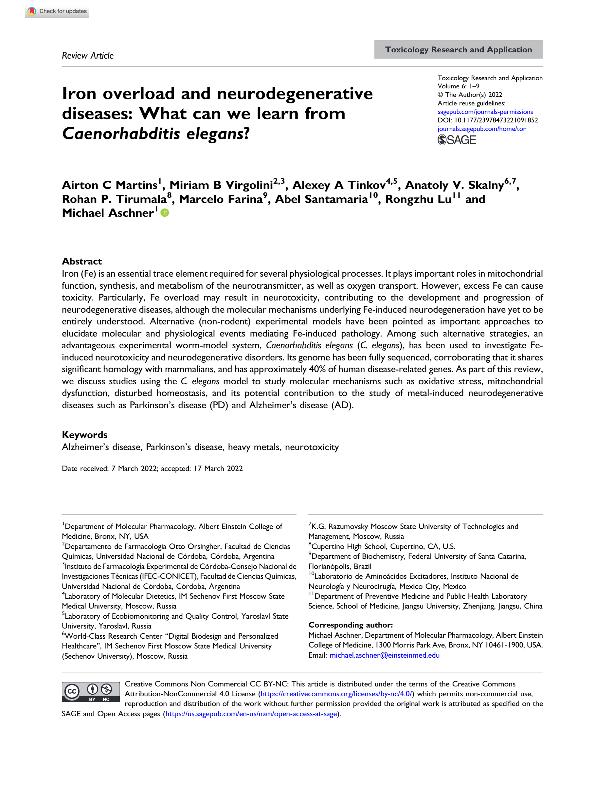Artículo
Iron overload and neurodegenerative diseases: What can we learn from Caenorhabditis elegans?
Martins, Airton C.; Virgolini, Miriam Beatriz ; Tinkov, Alexey A.; Skalny, Anatoly V.; Tirumala, Rohan P.; Farina, Marcelo; Santamaria, Abel; Lu, Rongzhu; Aschner, Michael
; Tinkov, Alexey A.; Skalny, Anatoly V.; Tirumala, Rohan P.; Farina, Marcelo; Santamaria, Abel; Lu, Rongzhu; Aschner, Michael
 ; Tinkov, Alexey A.; Skalny, Anatoly V.; Tirumala, Rohan P.; Farina, Marcelo; Santamaria, Abel; Lu, Rongzhu; Aschner, Michael
; Tinkov, Alexey A.; Skalny, Anatoly V.; Tirumala, Rohan P.; Farina, Marcelo; Santamaria, Abel; Lu, Rongzhu; Aschner, Michael
Fecha de publicación:
04/2022
Editorial:
SAGE Publications
Revista:
Toxicology Research and Application
ISSN:
2397-8473
Idioma:
Inglés
Tipo de recurso:
Artículo publicado
Clasificación temática:
Resumen
Iron (Fe) is an essential trace element required for several physiological processes. It plays important roles in mitochondrial function, synthesis, and metabolism of the neurotransmitter, as well as oxygen transport. However, excess Fe can cause toxicity. Particularly, Fe overload may result in neurotoxicity, contributing to the development and progression of neurodegenerative diseases, although the molecular mechanisms underlying Fe-induced neurodegeneration have yet to be entirely understood. Alternative (non-rodent) experimental models have been pointed as important approaches to elucidate molecular and physiological events mediating Fe-induced pathology. Among such alternative strategies, an advantageous experimental worm-model system, Caenorhabditis elegans (C. elegans), has been used to investigate Fe-induced neurotoxicity and neurodegenerative disorders. Its genome has been fully sequenced, corroborating that it shares significant homology with mammalians, and has approximately 40% of human disease-related genes. As part of this review, we discuss studies using the C. elegans model to study molecular mechanisms such as oxidative stress, mitochondrial dysfunction, disturbed homeostasis, and its potential contribution to the study of metal-induced neurodegenerative diseases such as Parkinson’s disease (PD) and Alzheimer’s disease (AD).
Palabras clave:
IRON
,
NEURODEGENERATION
,
ALZHEIMER
,
PARKINSON
Archivos asociados
Licencia
Identificadores
Colecciones
Articulos(IFEC)
Articulos de INST. DE FARMACOLOGIA EXPERIMENTAL DE CORDOBA
Articulos de INST. DE FARMACOLOGIA EXPERIMENTAL DE CORDOBA
Citación
Martins, Airton C.; Virgolini, Miriam Beatriz; Tinkov, Alexey A.; Skalny, Anatoly V.; Tirumala, Rohan P.; et al.; Iron overload and neurodegenerative diseases: What can we learn from Caenorhabditis elegans?; SAGE Publications; Toxicology Research and Application; 6; 4-2022; 1-9
Compartir
Altmétricas



